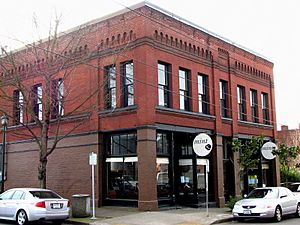Albina, Oregon facts for kids
Albina was a historic city in the United States state of Oregon. It was located on the east side of the Willamette River, across from Portland, Oregon. In 1891, Albina became part of Portland, along with East Portland. Today, the name Albina refers to a historic district within North and Northeast Portland.
Contents
Albina: A City's Journey
How Albina Began
The land where Albina was built was first claimed by J.L. Losing and Joseph Delay in 1850. They used a law called the Donation Land Claim Act. This act allowed people to claim land in Oregon if they lived on it and improved it.
Later, this land was sold to William Winter Page. In 1872, Page sold the land to George Henry Williams and Edwin Russell. These two men planned out the first streets and lots for the new town.
Williams and Russell decided to name the city "Albina." They chose this name to honor William Winter Page's wife and daughter, who were both named Albina.
Growing Up: Albina's Development
In 1874, Edwin Russell faced financial problems and left Oregon. James Montgomery and William Reid then bought the property. They began to build homes and develop the area for people to live there.
By 1880, Albina was still a small place, with only 143 people living there. However, things changed quickly. The city officially became incorporated in 1887. This meant it had its own local government.
By 1888, Albina's population had grown a lot, reaching 3,000 people. Many residents worked at the Oregon Railroad and Navigation Company's Albina railroad yards. These yards were a big employer in the city.
Becoming Part of Portland
Albina started as a small area. Its original borders were from Halsey Street north to Morris Street. It stretched from the Willamette River to Margareta Avenue. Margareta Avenue is now known as Martin Luther King Jr. Boulevard.
The city began to expand. In 1889, Albina added land north to Killingsworth Street and east to 24th Street. Then, in 1891, it grew even more. It annexed everything north to Columbia Boulevard and west to the Portsmouth area.
On July 6, 1891, a big change happened. The cities of Portland, East Portland, and Albina all joined together. They became one larger city, which is the Portland we know today.


